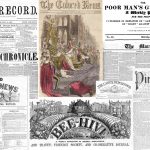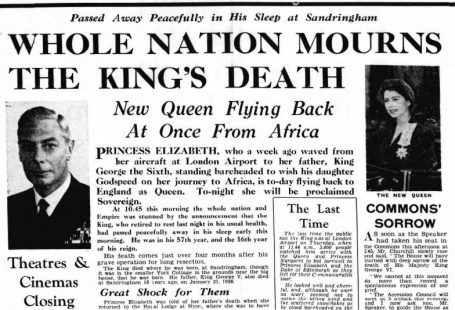‘Up to about forty or fifty years ago travelling was a solemn act, not to be enterprised nor taken in hand unadvisedly, lightly, or wantonly,’ so writes the Belfast News-Letter in September 1888. But all of this had changed; from the inception of the railways ‘day excursions’ had become ‘entirely modern pleasures,’ the British seaside and countryside opened up to visitors who could travel there easily by train.

This was the railway revolution, which opened up the seaside to ordinary, working class people. Brighton may formerly have been the preserve of princes, but now a cheap return ticket opened the watering place to the masses. The railway, with its improved infrastructure and cheap travel options, had created the day tripper, forever changing the landscape of seaside towns across the United Kingdom.
And so, in this special blog, using newspapers from our Archive, we will take a look at how the railway revolutionised the seaside, how it gave birth to the day tripper, and how it enabled millions to enjoy seaside breaks away.
Want to learn more? Register now and explore The Archive
Cheap Seaside Excursions
In May 1850, the Illustrated London News published this report on ‘Whitsuntide Holidays’ from the Brighton and South Coast Railway:
Excursion trains, on a most extensive and unprecedented scale, were run on this line during Monday. The announcement of from ‘London to Brighton and back for 3s 6d’ attracted such an immense concourse of persons as was never before seen waiting at London to visit that popular watering-place. Trains of vast extent were, however, provided for the accommodation of the public.
Meanwhile, at Waterloo, ‘a far greater number of passengers left the terminus,’ with an ‘immense number’ travelling to Southampton, Gosport and Portsmouth. Whilst an ‘immense crowd’ gathered at the terminus of the Gravesend railway, ‘anxious to pay a visit to famous old Gravesend and its many attractions.’ Extra trains were laid on to accommodate these day trippers, producing ‘such countless crowds as have been rarely seen in the town.’

Thus, just fourteen years after London’s first railway line had opened, the seaside railway phenomenon had begun. Spurred on by cheap tickets, and this new method of transport, London’s city dwellers could now expand their horizons, taking the opportunity of a rare day off afforded by Whitsun to travel further than they may ever have done before.
And it was not just a phenomenon that was confined to London. The Bolton Chronicle in July 1860 is advertising cheap tickets to the seaside:
Sea Bathing – Fleetwood, Blackpool, Lytham & Southport. Third-class return tickets, available for fourteen days, are issued every day to Southport, Lytham, Blackpool and Fleetwood, from the principle stations on the line, at very low fares, by all Third-class trains.

Meanwhile in Ireland, the Dublin Evening Post was advertising in July 1865 a cheap ‘sea bathing‘ excursion to Sligo and Bundoran. But what could you expect from these cheap seaside excursions?
Newspapers from the time furnish us with a wonderful idea of what you could expect from these early seaside railway trips, often giving full itineraries by way of advertisements. One such example can be found in the Maidstone Journal and Kentish Advertiser from 5 June 1865. This is an advert from the South Eastern Railway, for:
Cheap Sea-Side Excursions Every Sunday throughout the season; commencing on WHIT SUNDAY, 4th June, from MAIDSTONE to Dover, Ramsgate, Folkestone, Canterbury, Margate, Hastings.

You would have to be up bright and early; the excursion train would be leaving Maidstone at 7.20am. ‘Covered and closed carriages’ could be had for 3 shillings (just over £8 today), or you could travel second class for 5 shillings (nearly £15 today, or the approximate daily wage for a skilled labourer then). Children under twelve could claim half fares, whilst it was firmly stipulated that ‘no luggage [was] allowed.’ This, after all, was a day trip.
And for better or for worse, the day tripper was here to stay.
The Cheap Tripper
In June 1884 the Portobello Advertiser reports on the ‘Saturday Half-Holiday:’
Fine weather was enjoyed on Saturday last, and in the afternoon many people left Edinburgh to spend the usual half-holiday in the country or at the seaside. By rail large numbers of people made lengthened journeys to various destinations – the cheap Saturday fares provided by the railway companies being largely taken advantage of.

Some thirty years after the crowds descended upon the London railway termini, all across Great Britain the day trip had become cemented in the national tradition. And with it, the day tripper, who, ‘as a rule…prefers the seaside to the country.’ The day tripper could now travel far and wide thanks to the improved infrastructure of the railway and the cheap travel it offered, letting him be, so says the Belfast-News Letter, a ‘bird of passage – a day excursionist.’ The same article relates how:
He is frequently forbidden to carry luggage, save what he conveys in his arms, and is bound to journey to his goal and return from it on the same day.
Meanwhile, the Hartlepool Northern Daily Mail in August 1895 paints this immensely evocative tableau of ‘The Trippers’ Return:’
First-class carriage, crowded, returning by special from popular seaside town. Ladies sit on arm-rests and gentlemen’s knees; a file of trippers stand between seats. On racks bunches of seaweed and empty baskets, also mugs endorsed ‘A Present from the Seaside.’

And as you can probably tell from this brief survey, the day tripper had become a source of much satire, a figure that was even reviled in some quarters. Indeed, at a meeting of the Eastbourne Chamber of Commerce in 1897, one Councillor Simmons relates how he had been told that ‘at Hastings and Brighton the excursionists were ruining the season,’ as reports the Portsmouth Evening News.
Worse than this; Councillor Simmons describes how a fortnight ago ‘excursionists at Eastbourne behaved like wild beasts let loose.’ And who was to blame? The railway companies and their excursion trains. And so, the Eastbourne Chamber of Commerce resolved to send a deputation to the London and Brighton Railway Company to protest against the excursionists, and so ‘prevent Eastbourne degenerating to the level of other places,’ like Hastings and Brighton.

Meanwhile, one ‘Visitor’ at Weymouth was busy two years later firing off a letter in protest against ‘The Seaside Trippers‘ to the editor of the London Evening Standard. He begins his letter by referencing the same sort of action that the Eastbourne Chamber of Commerce had planned:
Sir – No one who enjoys quiet, with amusement of a reasonable kind, can be surprised at the action, now threatened by the authorities of many sea-side health resorts, against the vast increase of excursion trains. I came here with my family a few weeks since, having heard of the natural beauties of the place and its reputed healthiness. As to the the former, he, indeed, would be hard to please who was not satisfied. About the latter, i.e., its healthiness, I will speak further on.

He continues:
I wish first to protest against the whole town being turned into a quasi Bedlam let loose by the hordes disgorged day after day by ‘trippers’ trains. The whole of the otherwise pretty esplanade and sea front is filled with a seething multitude of all ages, which resembles a swarm of bees in its most fussy and obnoxious state.
He also objects to the bathing taking place ‘immediately before [his] windows,’ ‘without limit or cessation.’ Indeed, the bathing arrangements appear somewhat scandalous as per the standards of the day:
I may say that thousands during the day are always seen (and there is no way of escaping the sight) in all sorts of bathing dresses, many extremely meagre, and hardly decent, amusing themselves in the water, which all along the front is extremely shallow….There is little or no distance enjoined between the positions of the male and female bathers, while the whole of the shore is usurped by ‘trippers’ and their attendant nuisances.

But there was no avoiding it, despite the protests of our Weymouth holiday maker. The day tripper was here to stay, with the railway companies making sure that they did.
Railway Holiday Arrangements
Indeed, the excursions offered by the railways were an important source of income for the railway companies, and indeed, an important source of income to the towns that the day trippers visited. And so vital were these excursions for both the day trippers and the railway companies, that newspapers would regularly feature upcoming ‘Railway Holiday Arrangements,’ as the Sporting Life details in April 1898:
As is usual, the arrangements made by the railway companies for this favourite holiday afford adequate opportunities to the excursionist, journeying either north, south, east, or west, for a brief period to the country or seaside, and intending holiday-makers will find the interesting particulars set forth in our advertisement columns well worth perusal.

Laid out in Sporting Life were details of the London, Brighton and South Coast Railway Company’s services to the seaside, as well as the ‘cheap tickets’ offered by the Great Western Railway Company, and the ‘cheap day excursions’ to such places as Ramsgate, Margate and Hastings, put on by the South Eastern Railway Company.
And the seaside railways also produced new business opportunities, such as the opening up of new hotels and resorts. Truth in June 1898 advertises one such new resort at Cruden Bay, Aberdeenshire:
A New Seaside Resort. Rail from Aberdeen by the new Cruden Railway. Sheltered Beach. Golf, Bathing, Sea Fishing. Fine Coast Scenery. The Company’s splendid new hotel at Cruden Bay will be ready for the reception of visitors shortly.

Meanwhile, the excursion trains offered by railway companies gave previously neglected seaside towns the chance to expand. This is from the East Anglian Daily Times in April 1905:
East Coast watering places within the last few years have entered into keen competition with southern seaside resorts, and it is probable that, in the coming summer, seaside towns served by the Great Eastern Railway will become even stronger competitors for patronage.
And the Great Eastern Railway Company was on hand to drive more visitors to the East Coast, providing a ‘special non-stop train’ from London to Felixstowe every Friday, ‘timed to leave Liverpool Street at 4.10’ in the afternoon. There would be another Felixstowe express laid on every Saturday too, stopping only at Ipswich, leaving at 1.30pm.

Provision was also being made for Clacton, with an ‘express half-day excursion’ leaving Liverpool Street, stopping at Stratford only, the journey lasting an hour and a half and costing ‘the modest sum of 3s return’ (worth £11 today).
The Rush to the Sea
But the day trippers’ delight was to come to a brief halt with the First World War. Indeed, the same East Coast towns which were hoping to encourage more visitors found themselves under German bombardment. This, however, was just a temporary trouble for the tripper, as the Globe reports in May 1920:
When the East Coast towns were being bombarded and air raids were fashionable the tripper disappeared from the Great Eastern terminus and one travelled in luxurious isolation. Now Yarmouth, Lowestoft, Felixstowe, Clacton, and the rest have recovered from the nightmare of the war, and the old, familiar scene of giddy trippers, swarming round the platform gates like a disturbed ant-hill, is to be witnessed once more.

Indeed, the 1920s and 1930s were to be the heyday of the railway day tripper, in a time before the majority of the population had cars, and still relied on the railways.
And the railways had to be prepared for unexpected periods of good weather. October 1921 saw remarkably fine weather for the season, which meant that ’emergency excursions were run from London to cope with the phenomenal demands on the trains,’ as relates the Sunday Illustrated. Officials from London stations told the press that they ‘had gone back to summer services,’ as it was 77 degrees in the shade, women wearing their ‘flimsy August frocks’ and ‘ice-cream barrows’ were back out and about.
The Sunday Illustrated continued:
Waterloo-station was crowded; the trains loaded to their utmost, and even standing was tolerated with a humour and forbearance only associated with the month of August. From London Bridge and Victoria special emergency excursions were run, and Liverpool-street saw a great rush of visitors to Felixstowe and Clacton.

And that was for unexpected good weather – what happened when the holiday season began ‘in earnest?’ The Pall Mall Gazette paints a wonderful picture of ‘Londoners’ Rush to the Sea‘ in July 1922, with ‘stations besieged’ and ‘trains packed.’ The article relates how:
From an early hour this morning the two great termini at Victoria were packed almost to suffocation with week-enders, old, young, and infantile, anxious to seek the sea.

Trains were ‘triplicated,’ with ‘queues at the booking-office…as long as forty yards, and in places were four abreast.’ Meanwhile, at Liverpool Street:
…the exodus to the East Coast was equally marked. The steep incline leading to the main booking office was one long, patient queue, which overflowed both right and left into the street.
There were also unprecedented scenes at ‘the usually placid precincts of Paddington Station,’ with cheap tickets opening up the West Country for trippers, the Pall Mall Gazette explaining how:
Paignton and Torquay are becoming increasingly popular week by week, for people are beginning to realise that they can obtain tickets covering from Saturday to Monday at these two places, including meals and accommodation, for £3 10s, and £3 4s 6d, respectively.

And as the years went on, excursion trains got more and more sophisticated. The Sheffield Daily Telegraph tells of a new scheme, inaugurated in 1939 by the L.M.S., whereby:
… people who get their tickets in advance receive, in addition, free of cost, tickets guaranteeing them seats. More than 6,000 people have availed themselves of the facilities. Blackpool will be the most popular resort, with Scarborough and the East Coast resorts following closely behind. Morecambe and Llandudno will also be popular.
By the end of August 1939, on the eve of another catastrophic world war, 40,000 extra trains were expected to carry holiday makers to the seaside. 20 million people were anticipated to take their holidays at the same time, and so the Manchester Evening News relates how British holiday resorts were petitioning for a ”staggered’ holiday system.’ The article contains a comment from an official representing the Blackpool Corporation:
The trouble is not with Lancashire or Yorkshire, but the towns in the Midlands and the South, which still take August Bank Holiday week for their annual holiday. If they all followed the system of the wakes weeks it would make a big difference. In Blackpool, there are between 300,000 and 400,000 people. Every place is working to capacity, and we have had to find a big number accommodation in apartment houses. Many of them were unable to obtain it by writing.
But change was in the air. Trains that were taking trippers on their holidays in August were now in early September evacuating children away from cities. After the war, however, the railways would come back into their own, before they were overtaken by widespread car ownership, and the rush to the sea would take place on motorways.

The railways have helped to shape the British seaside as we know it today, and many of us still take advantage of them for day trips and for our holidays, especially for staycations this year!
What railway stories can you discover in the pages of our Archive? Start you search here today.





